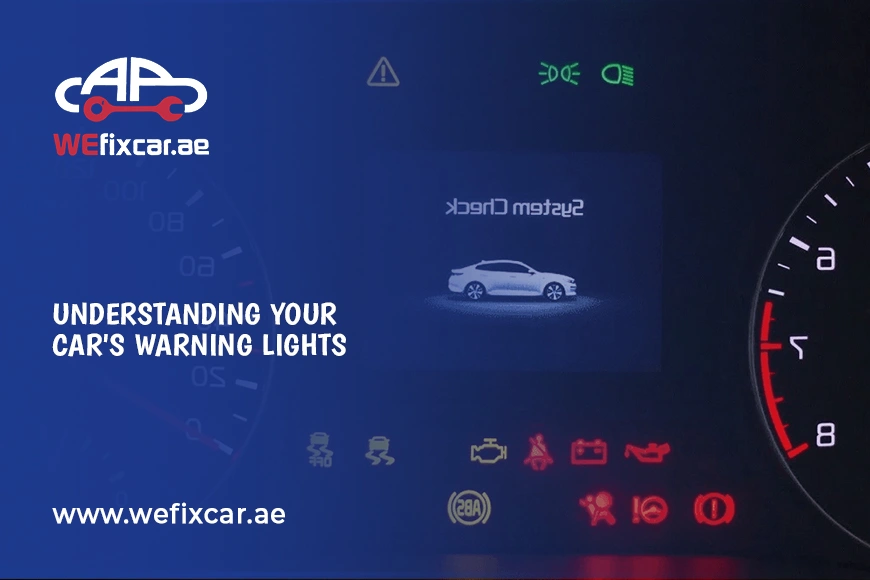Your car’s warning lights are designed to keep you informed about potential issues before they become serious problems. Ignoring them can lead to costly repairs or even accidents. Understanding these dashboard alerts can help you take quick action to ensure your vehicle remains in top condition.
Need professional help with your car’s warning lights? Visit We Fix Car for expert diagnostics and reliable repair services!
The Importance of Warning Lights
Modern vehicles come equipped with advanced dashboard warning systems that monitor various components, ensuring your car operates efficiently and safely. These indicators alert you to possible malfunctions in:
- Engine and transmission
- Braking system
- Battery and charging system
- Oil pressure and coolant temperature
- Tire pressure and traction control
Recognizing these alerts and acting promptly can prevent breakdowns and improve your vehicle’s lifespan.
Common Warning Lights and Their Meanings
1. Check Engine Light
- Symbol: Engine-shaped icon (yellow or orange)
- Meaning: Indicates potential issues ranging from a loose gas cap to serious engine malfunctions.
- Action: If flashing, stop driving immediately and seek professional assistance. If steady, schedule a diagnostic check soon.
2. Battery Warning Light
- Symbol: Battery icon
- Meaning: Suggests problems with the charging system, such as a failing alternator or corroded battery terminals.
- Action: Avoid using electrical accessories and have your battery and alternator inspected.
3. Oil Pressure Warning Light
- Symbol: Oil can with a drop
- Meaning: Indicates low oil pressure, which can lead to severe engine damage if ignored.
- Action: Stop the car immediately, check oil levels, and refill if necessary. If the light remains on, seek professional help.
4. Brake System Warning Light
- Symbol: Circle with an exclamation mark or the word “BRAKE”
- Meaning: Could indicate low brake fluid, worn brake pads, or an issue with the anti-lock braking system (ABS).
- Action: Check brake fluid levels and consult a mechanic if needed.
5. Coolant Temperature Warning Light
- Symbol: Thermometer with wavy lines
- Meaning: Signals an overheating engine, often due to low coolant levels or a failing radiator.
- Action: Turn off the engine, let it cool down, and check coolant levels before driving further.
6. Tire Pressure Monitoring System (TPMS) Light
- Symbol: Exclamation mark inside a flat tire icon
- Meaning: Indicates low tire pressure, which can affect fuel efficiency and handling.
- Action: Inflate tires to the recommended pressure or check for punctures.
7. Airbag Warning Light
- Symbol: Seated passenger with a deployed airbag
- Meaning: Suggests an issue with the airbag system, which may prevent deployment in an accident.
- Action: Have your vehicle inspected by a technician to ensure safety.
Want to avoid costly car repairs? Book a maintenance check with We Fix Car today and drive with confidence!
How to Respond to Warning Lights
- Stay Calm: Panicking can lead to poor decision-making.
- Check the Owner’s Manual: It provides specific details about each warning light.
- Assess Urgency: Flashing lights indicate immediate action is needed, while steady lights suggest a minor issue.
- Take Necessary Action: Depending on the severity, either drive cautiously to a service center or pull over and call for assistance.
Preventing Warning Light Issues
- Regular Maintenance: Routine servicing helps detect potential problems before they escalate.
- Use Quality Fluids: Always opt for manufacturer-recommended oil, coolant, and brake fluid.
- Monitor Tire Pressure: Keep tires properly inflated to prevent TPMS warnings.
- Battery Care: Ensure battery terminals are clean and connections are secure.
Final Thoughts
Understanding your car’s warning lights is essential for maintaining safety and performance. By recognizing common dashboard alerts, taking prompt action, and scheduling regular maintenance, you can keep your vehicle running smoothly.
Experiencing dashboard warning lights? Let We Fix Car diagnose and fix the issue for you! Contact us now!
FAQs
- Can I drive with a check engine light on?
If the check engine light is steady, you can drive cautiously but should have it checked soon. If it’s flashing, pull over and seek assistance immediately.
- What does it mean if the oil pressure light turns on while driving?
It indicates low oil pressure, which can severely damage the engine. Stop driving immediately and check oil levels.
- How often should I check my tire pressure?
Check tire pressure at least once a month and before long trips to ensure proper inflation.
- Why does my battery light come on and then go off?
This could indicate a loose alternator belt or an intermittent charging issue. Have it checked to avoid a breakdown.
- How can I reset a warning light?
Some warning lights reset automatically after addressing the issue. Others may require a diagnostic tool or professional service.



